Nsg6005 quiz 2 q bank - Study guides, Class notes & Summaries
Looking for the best study guides, study notes and summaries about Nsg6005 quiz 2 q bank? On this page you'll find 8 study documents about Nsg6005 quiz 2 q bank.
All 8 results
Sort by
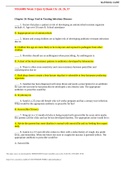
-
NSG6005 Week 3 Quiz Q Bank Ch: 24, 26, 37 Latest Guide 2023
- Exam (elaborations) • 6 pages • 2023
-
- $10.49
- + learn more
1. Factors that place a patient at risk of developing an antimicrobial resistant organism include: A. Age over 50 years B. School attendance D. Inappropriate use of antimicrobials ____ 2. Infants and young children are at higher risk of developing antibiotic-resistant infections due to: B. Children this age are more likely to be in daycare and exposed to pathogens from other children ____ 3. Providers should use an antibiogram when prescribing. An antibiogram is: D. A chart of the local ...
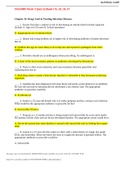
-
NSG6005 Week 3 Quiz Q Bank Ch: 24, 26, 37 Latest Guide 2023
- Exam (elaborations) • 6 pages • 2023
-
- $10.49
- + learn more
1. Factors that place a patient at risk of developing an antimicrobial resistant organism include: A. Age over 50 years B. School attendance D. Inappropriate use of antimicrobials ____ 2. Infants and young children are at higher risk of developing antibiotic-resistant infections due to: B. Children this age are more likely to be in daycare and exposed to pathogens from other children ____ 3. Providers should use an antibiogram when prescribing. An antibiogram is: D. A chart of the local ...
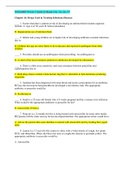
-
NSG6005 Week 3 Quiz Q Bank Ch: 24, 26, 37
- Exam (elaborations) • 6 pages • 2023
-
- $7.00
- + learn more
NSG6005 Week 3 Quiz Q Bank Ch: 24, 26, 37 Chapter 24: Drugs Used in Treating Infectious Diseases ____ 1. Factors that place a patient at risk of developing an antimicrobial resistant organism include: A. Age over 50 years B. School attendance D. Inappropriate use of antimicrobials ____ 2. Infants and young children are at higher risk of developing antibiotic-resistant infections due to: B. Children this age are more likely to be in daycare and exposed to pathogens from other children ___...
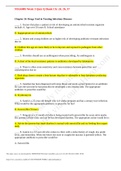
-
NSG 6005 - WEEK 3 Quiz Q_Bank.
- Exam (elaborations) • 6 pages • 2021
-
- $15.49
- + learn more
NSG 6005 - WEEK 3 Quiz Q_Bank. / NSG 6005 - WEEK 3 Quiz Q_Bank. NSG6005 Week 3 Quiz Q Bank Ch: 24, 26, 37 Chapter 24: Drugs Used in Treating Infectious Diseases ____ 1. Factors that place a patient at risk of developing an antimicrobial resistant organism include: A. Age over 50 years B. School attendance D. Inappropriate use of antimicrobials ____ 2. Infants and young children are at higher risk of developing antibiotic-resistant infections due to:
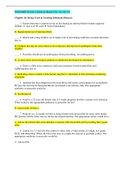
-
NSG6005 Week 3 Quiz Q Bank Ch: 24, 26, 37
- Exam (elaborations) • 6 pages • 2021
-
- $10.00
- + learn more
NSG6005 Week 3 Quiz Q Bank Ch: 24, 26, 37 Chapter 24: Drugs Used in Treating Infectious Diseases ____ 1. Factors that place a patient at risk of developing an antimicrobial resistant organism include: A. Age over 50 years B. School attendance D. Inappropriate use of antimicrobials ____ 2. Infants and young children are at higher risk of developing antibiotic-resistant infections due to: B. Children this age are more likely to be in daycare and exposed to pathogens from other children ___...
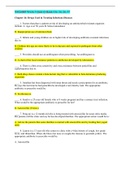
-
NSG6005 Week 3 Quiz Q Bank Ch: 24, 26, 37
- Exam (elaborations) • 6 pages • 2021
-
- $10.00
- + learn more
NSG6005 Week 3 Quiz Q Bank Ch: 24, 26, 37 Chapter 24: Drugs Used in Treating Infectious Diseases ____ 1. Factors that place a patient at risk of developing an antimicrobial resistant organism include: A. Age over 50 years B. School attendance D. Inappropriate use of antimicrobials ____ 2. Infants and young children are at higher risk of developing antibiotic-resistant infections due to: B. Children this age are more likely to be in daycare and exposed to pathogens from other children ___...
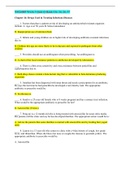
-
NSG6005 Week 3 Quiz Q Bank Ch: 24, 26, 37
- Exam (elaborations) • 6 pages • 2021
-
- $8.00
- + learn more
NSG6005 Week 3 Quiz Q Bank Ch: 24, 26, 37 Chapter 24: Drugs Used in Treating Infectious Diseases ____ 1. Factors that place a patient at risk of developing an antimicrobial resistant organism include: A. Age over 50 years B. School attendance D. Inappropriate use of antimicrobials ____ 2. Infants and young children are at higher risk of developing antibiotic-resistant infections due to: B. Children this age are more likely to be in daycare and exposed to pathogens from other children ___...
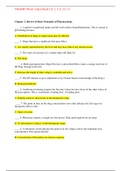
-
NSG WEEK 2/ NSG6005 WEEK 2 EXAM STUDY GUIDE. QUESTIONS AND 100% CORRECT ANSWERS
- Exam (elaborations) • 12 pages • 2021
-
- $22.99
- + learn more
NSG6005 Week 2 Quiz Bank Ch: 2, 5, 6, 10, 13 Chapter 2: Review of Basic Principles of Pharmacology ____ 1. A patient’s nutritional intake and lab work reflects hypoalbuminemia. This is critical to prescribing because: A. Distribution of drugs to target tissue may be affected ____ 2. Drugs that have a significant first-pass effect: C. Are rapidly metabolized by the liver and may have little if any desired action ____ 3. The route of excretion of a volatile drug will likely be: B. The lu...

$6.50 for your textbook summary multiplied by 100 fellow students... Do the math: that's a lot of money! Don't be a thief of your own wallet and start uploading yours now. Discover all about earning on Stuvia


